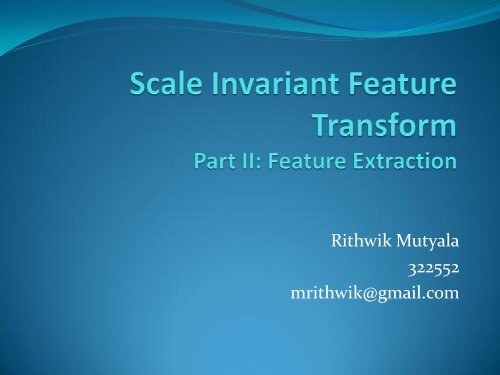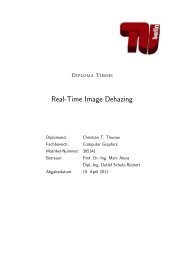Scale Invariant Feature Transform
Scale Invariant Feature Transform
Scale Invariant Feature Transform
You also want an ePaper? Increase the reach of your titles
YUMPU automatically turns print PDFs into web optimized ePapers that Google loves.
Rithwik Mutyala<br />
322552<br />
mrithwik@gmail.com
Key Steps of SIFT<br />
� <strong>Scale</strong>-space extrema detection<br />
� Keypoint detection, scale invariance<br />
� Keypoint Localization<br />
� Stable keypoint selection<br />
� Orientation Assignment<br />
� Orientation invariance and calculation of local image<br />
gradient directions<br />
� Keypoint Descriptor<br />
� Variations: Local shape distortion and change in<br />
illumination
Orientation Assignment<br />
Image from: Lowe 2001
Orientation Assignment<br />
� Selection of same scale as keypoint for Gaussian<br />
smoothed Image L � <strong>Scale</strong> Invariance<br />
� m(x,y) � Gradient Magnitude<br />
Θ(x,y) � Orientation<br />
�L( x �1, y) � L( x �1,<br />
y)<br />
�<br />
GradientVector � �<br />
L( x, y �1) � L( x, y �1)<br />
�<br />
� �
Orientation Assignment<br />
Image from: Jonas Hurrelmann
Image from: Jonas Hurrelmann
� Dimensions of X-Axis (Bin Number)<br />
Image from: Jonas Hurrelmann
Orientation Assignment<br />
� Orientation histogram<br />
� Gradient orientations of sample points within a region<br />
around the keypoint<br />
� Each sample is weighted by 1) Gradient Magnitude<br />
2) Guassian Circular<br />
Window; Smoothing<br />
� Multiple keypoints<br />
� The highest peak is detected (Magnitude H)<br />
� Peaks with 80% of H are used to create multiple vectors<br />
for the same keypoint
Local Image/Region Descriptor<br />
� Next Step is to compute a descriptor for the local image<br />
region<br />
� Similar mechanism to Inferior Temporal Cortex in primates<br />
Image from: Jonas Hurrelmann
Local Image Descriptor<br />
� Orientation histograms allow for significant shift in<br />
Gradient position (and thus provide 3D view variations<br />
with different viewpoints)<br />
� 4x4x8=128 feature vector for each keypoint; this then is<br />
a unique descriptor for the keypoint.<br />
� Illumination Invariance: Normalization of Orientation<br />
vectors to 1
QUESTIONS<br />
Image from: T.Tuytelaars ECCV 2006 Tutorial
Thank You For your Patience
References<br />
� Object Invarience from Local-<strong>Scale</strong> <strong>Invariant</strong><br />
<strong>Feature</strong>s;Lowe 1999<br />
� Disntinctive Image features from <strong>Scale</strong>-<strong>Invariant</strong><br />
Keypoints; Lowe 2004<br />
� Local <strong>Feature</strong> View Clustering for 3D object<br />
recognition; Lowe 2001




